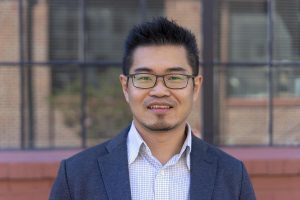(“Text as submitted by architect”)
 Fred Liao
Fred Liao
Fred Liao is the founder and a director of PLAT Studio. He has engaged his passion for large-scale landscape and urbanism as a multi-disciplinary practice. He is a licensed landscape architect with extensive large-scale, site-specific masterplan and landscape design experience in both North America and Asia, building large urban parks, mixed-use developments, as well as office and academic campuses. His work focuses on conceptualization, systematic framework, and design studies; he envisions design as a dynamic process of investigating site potentials culturally, ecologically and economically, for timeless placemaking, and a more sustainable world.
Prior to starting PLAT Studio, Fred was involved in high-profile and design-oriented projects with multi-disciplinary teams, including New York World Trade Center Public Realm, Fresh Kills Park Master Plan, Taiwan Hengchun Tropical Botanic Garden, and Kunshan High School Campus. These projects require the consolidation of infrastructure, architecture and structure through cross-disciplinary design, coordination, and management through all project phases.
Fred received his Master of Landscape Architecture from University of Pennsylvania where he was awarded the ASLA Certificate of Honor and George Madden Boughton Prize. He is a licensed landscape architect in New York, Pennsylvania and a LEED AP.
 Kit Wang
Kit Wang
As a project director at PLAT Studio, Kit Shih-Ting Wang ensures a constant synergy between design intent and the many technical challenges that we address with our collaborators. With degrees in architecture, landscape architecture and planning, she provides solutions in all project phases. She is a certified planner in the United States and a LEED Accredited Professional.
Kit’s professional interest is urban design that integrates contemporary landscape and architectural design. She cares about aesthetic, ecological and social values and is dedicated to creating beautiful, ecologically constructive and socially vital spaces in our cities. Her award-winning competitions include architectural designs, memorial parks, post-industrial parks and future solar energy applications.
Kit received her Master of Landscape Architecture and Master of City Planning at University of California at Berkeley, USA. She also earned Bachelor of Architecture, Tamkung University and a Certificate in Project Management from University of California Extension at Irvine, USA.
 Shih-lin Lan
Shih-lin Lan
As a project director at PLAT Studio, Shih-Lin Lan specializes in design studies, visualization, and detail design. His wide-ranging experience, spanning from site-specific, built landscapes to campus master planning, gives him a keen design vision. Like his varied interests, he is focused on public waterfronts and plazas, mixed-use developments, and the design of both business and academic campuses.
Prior to joining PLAT Studio, Shih-Lin was a part of the design team for The Edge Waterfront Park in Brooklyn, the World Trade Center Public Realm Design in New York, as well as the Jianwan New Town in Shanghai. Shih-Lin received his Master of Landscape Architecture degree from University of Pennsylvania, and Bachelor of Landscape Architecture degree from Fu-Jen University.
Practice Ideology
Our practice works to bring sustainable and timeless places to life by integrating landscape architecture, urbanism, and research in our process and by thinking about our designs as a part of a larger environmental and societal framework. We strive to instill the site’s historical and cultural assets into our designs to create meaningful places for clients, visitors, and community. By seeking innovative approaches to site limitations, we are able to create progressive, innovative places for all. PLAT Studio strives to create livable, attractive, and sustainable places that serve the needs of the present and the future and that exceed the limitations of time to become an integral part of the urban and social fabric. We accomplish this by looking closely at the site’s unique site features: topography, ecology, history, and culture and by working with those existing conditions to create designs that respect the spirit of the place while making progressive strides towards a framework that supports future growth. This respect allows us to create places that can adapt and harmonize with the surrounding landscape and its existing rhythms.
By thinking about our built landscape as a synthesis of systems, we desire to position the landscape as a framework for positive growth. We understand the economy, architecture, infrastructure, government, social fabric, structure, and environment of the site through research and put our designs through a rigorous design process to ensure that the landscapes we design are progressively innovative and support flexibility in future growth. As landscape architects, urban designers, and architects, we believe that a powerfully constructed landscape has the potential to knit together otherwise incongruent land uses, socially disparate communities, and underutilized ecological systems. It is a powerful tool vital to the health of our economic, social, and environmental future.


